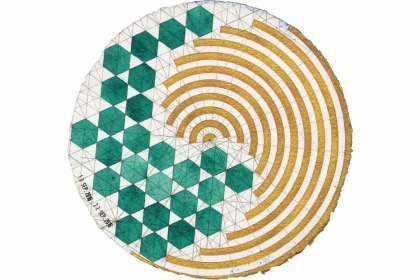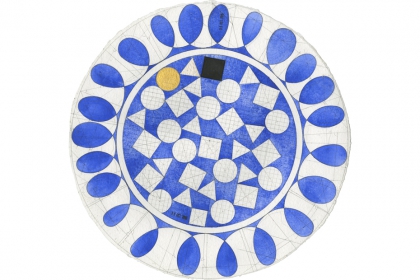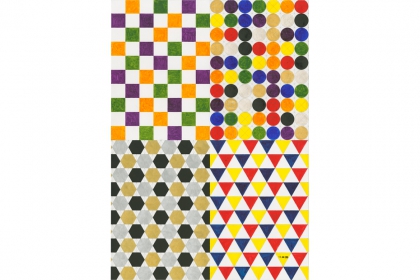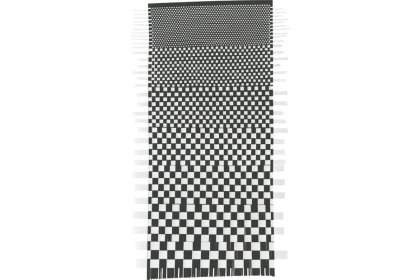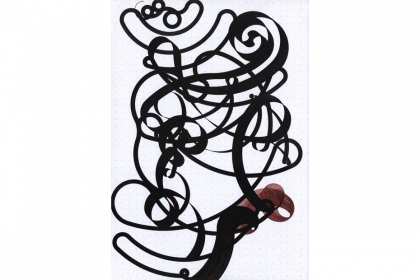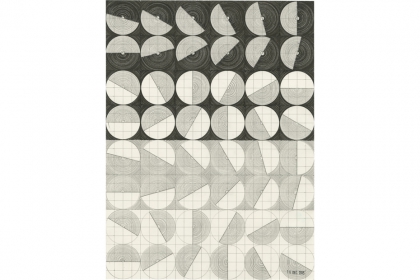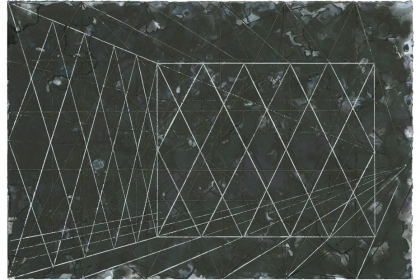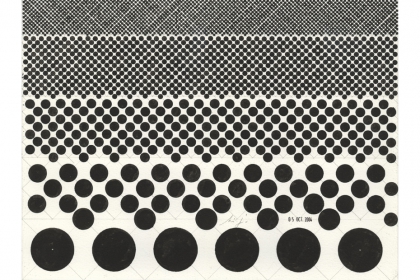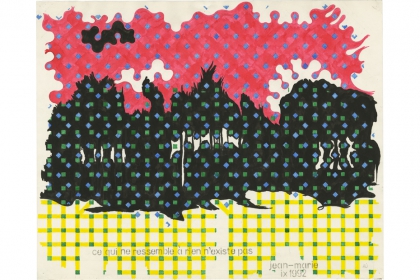Daily, forever
Imagine the following scene: on a table in a room in a house in Brussels, space is made to lay down a sheet of paper. The books, the piles of papers and laptop that are usually on the table have been pushed aside to make room for drawing materials. Pencils, pens and brushes are placed beside an eraser and a scalpel. There is a ruler, a compass, perhaps a protractor; there are circle templates and drawing moulds of different curvatures. Ink and watercolour paint in different colours stand at the ready.
It is 11 December 2003. On the table in the room in the house in Brussels is a sheet of drawing paper measuring 24 x 32 centimetres. Henri Jacobs has set himself the task of making a drawing, but as yet there is no subject. On the sheet of paper, lines are drawn in a large arc from bottom left to top right and then again to bottom left. The edges of the paper function as a frame that limits the movement of the drawing. The lines condense, but the middle of the sheet remains relatively empty. It forms an eye, just like the calm centre of a whirlwind. Over the pencil lines, ink lines are drawn, first in the same direction but here and there they make a sharp corner and shoot out like black rays through the imaginary space that the curved lines suggest. This is the first Journal Drawing by Henri Jacobs. An image materialises: the empty, white paper is transformed into a drawing entitled Plafond (001).
In autumn 2003, Jacobs instructed his students at the Royal Academy of Art in The Hague to observe like a camera – not with the wide, human gaze that takes in everything but with the focus of a camera lens. Each day, draw something that has struck you, something you have seen or thought - do it quickly and keep it small, he told them. That simple advice to alleviate the apathy that seemed to weigh his students down, also appeared appropriate for himself, as a means to escape the straightjacket imposed by a series of complex and laborious watercolour paintings. Jacobs became his own student. To sit at a table and to draw, no matter what, drawing just for the sake of drawing, felt like a liberation.
Perhaps the ceiling of the room that served as his studio really was the subject of the first Journal Drawing, but what it actually looked like is irrelevant. The drawing is not a true representation of the ceiling; it is no more than a pretext and therefore as good as any other subject. Such a pretext can be abstract or concrete, an idea or observation – it can be trivial or elevated, because both the pattern of the pavement noticed by Jacobs while out walking the dog Luckie or quotes from philosophers such as Friedrich Nietzsche and Emil Cioran are equally explored in his drawings. Even boredom can be a subject, as seen in Étude de l’ennui (319), the title of the Journal Drawing from 17 April 2007.
Discover freedom through discipline, find surprise in the routine, and make from the problem the solution. This is the directive that led to 666 Journal Drawings in less than ten years. On average 70 drawings per year, one drawing every five days. Sometimes one drawing is made every day, sometimes two, but the latter only under exceptional circumstances. Usually there are intervals of one or several days, for example, waiting for watercolour paint to dry before drawing can continue, or gaps of several weeks when a holiday is celebrated and for other urgent matters, such as completing a commission or setting up an exhibition. Consecutive drawings often form small series in which one image emerges from the next until something new presents itself. A logical series of related motifs is then abruptly interrupted but also sometimes continued. And some motifs appear to be worth repeating later on, like a forgotten thought that suddenly resurfaces after several months or even years. For example, the ‘eye’ of the first Journal Drawing (001) returns after two years as a ‘hole’ in Étude de sculpture (182) from 6 September 2005 and again, six years later, on the horizon of Paysage vide (548) from 29 June 2011.
The fact that individual drawings belong to a series that develops over a long passage of time is emphasised by a serial number and date. At first, the serialised character of the drawings was expressed in terms of physical preconditions: only using horizontal sheets of 200 grams Dalbe or Canson drawing paper measuring 24 x 32 centimetres and a Pentel pencil, a Rotring technical drawing pen and Winsor & Newton watercolour paints. Gradually, this self-imposed limitation was relaxed and the diversity of papers was enlarged creating a greater variety of formats and surfaces.
The adage ‘keep it small’ no longer held true when on 25 April 2011, Jacobs made the large assembled drawing Le soupçon inachevé (519). A portrait format was first used on 12 April 2006 (236) and on 5 April 2012, Jacobs began a series of ten square drawings of grids that was completed on 21 May of that year (622-631). For larger formats, the artist used 300 grams grain torchon or grain fin Arches watercolour paper. With the drawing Catastrophe (284) from 6 November 2006, the heavy 400 grams Moulin de Larroque watercolour paper with rough edges makes an entry. The material counterpart of that paper is the smooth and taut Epson Premium Glossy photo paper, which lends itself perfectly to the pulsating, almost psychedelic series Amuletten, nine interrelated patterns pointing to the family relationships and characters from the TV series The Sopranos (412-420), Jacobs’ favourite comedie humaine. He also uses old, yellowed drawing paper from Talens measuring 10 x 15 centimetres, which had lain forgotten in a portfolio in the attic. And finally, as of 2009, drawings made on the pages of sketchbooks occasionally enter the Journal Drawings (447-450, 644, 656, 657, 659, 665, 666).
While this variety of formats and papers only increases gradually over time, the execution of each drawing was from the outset entirely different. During ten years, an encyclopaedic overview emerges of the limitless possibilities within self-imposed limitations. There are drawings in pencil, in ink, and in watercolour paint or in a combination of these materials; there are freehand drawings or drawings orchestrated by chance, and still more often, there are drawings that are systematically constructed with a ruler and compass. In these drawings, the harmonious measurements of the Golden Rule or Kepler’s triangle form the basis of different grids and hatching that overlap, layer upon layer, until a satisfactory image or pattern appears. Whilst drawing, the intermediary stages – the different states of the drawing – are recorded as scans, giving them the right to exist as independent drawings. But the intermediary stages fall prey to the next phase and are sacrificed until a final image is attained. The first time we can follow this process is in a watercolour study of a cloudy sky made by Jacobs on 14 March 2004 (from 036A to 036D). Not entirely destroyed or completely invisible, earlier stages can still be seen in the final image, making the drawing similar to a palimpsest, a sheet of writing parchment that is reused but still shows traces of the first inscriptions.
Although drawing itself is the primary subject matter of the Journal Drawings, the artistic drawing parameters of materials and methods do not determine the cohesion of the series. Crucial to this is the choice of the word journal. In Dutch – Jacobs’ mother tongue – the word ‘journaal’ is above all associated with daily broadcast news on public television, while in English just as in French, it is associated with daily newspapers. In both cases, the association with news and daily reporting is strong. With regard to the Journal Drawings, ‘news’ should not be construed as the recording of relevant or trivial daily events as they occur, although current affairs do occasionally surface: for example, the text ‘No one is illegal’ is hidden in the Étude de façade (185) from 12 September 2005, an indignant reference to the continuously vehement debate on the position of immigrants. ‘News’ in this case is best associated with the progress of time, emphasised by the precise dating of each drawing (an undated drawing would be ‘timeless’) and by the publication of each new drawing on Jacobs’ website once it is finished. The newest drawing leaves the older drawing behind: time endlessly overwrites itself as a continuously repeating palimpsest.
The chronological connection between the drawings, through their numbering and dating, indicates the inexorable rhythm of the days, months and years. Within this larger whole, smaller, thematically cohesive series of drawings also form a smaller chronological unity of a number of days, a week or a month. They reveal a certain period during which the artist focused on the elaboration of a specific motif or subject. This cohesion becomes clearly apparent through the structuring of this book. And above all, here the discipline of the daily, self-imposed task that was performed for ten years is manifest. Ultimately, it led to the complex construction that the 666 Journal Drawings form together, but at the same time, and paradoxically, within the discipline of daily drawing there lies a strong desire for a simplicity that will counterbalance the hectic complexity of everyday life. Similar to other artworks that came about over a long period of time – for example, the Date Paintings by On Kawara or the number paintings by Roman Opalka – the Journal Drawings are also a form of contemplation and even exhibit traces of a rule of life. This is evident in the drawing Poem, made on 14 June 2012 (644). Seven verbs drawn with stencils suggest what a day in a life of Arcadian simplicity can consist of:
PLOWING
BRICKLAYING
KNITTING
WEAVING
COOKING
FUCKING
SLEEPING
But the regular rhythm of the days, months and years is not the only trail to follow through the Journal Drawings. There are also combinations that are whimsical and restive, which traverse time and ramble through the labyrinth of Jacobs’ visual poetics and memory. On 8, 9 and 13 November 2012 for example, he completed three drawings ‘after Matisse’ (660-662) having made two sketches on 5 November of an ‘8 and 16-fingered’ motif (659). The reason for these sketches is easy to detect. They are undoubtedly based on the leaves of the finger plant integrated with great virtuosity by Matisse in his monumental collage La perruche et la sirène. Following the reopening of the Stedelijk Museum in Amsterdam in September 2012, this artwork was at last on show again after many years. The form that ‘fingers’ take had already attracted Jacobs’ attention at an earlier date. Finger, Hand & Accident Drawing After Jasper Johns (356) from 3 July 2007 explicitly points to Johns’ iconic drawing Untitled (1978). Johns used his fingers to hatch a pattern on a sheet of paper. This pattern then formed the basis for a series of paintings. The effective simplicity of the method apparently remained lodged in Jacobs’ memory because whilst drawing an exhaustive series of precise arabesques, he suddenly makes Back to basic (437), using the basic gesture of finger painting to break the routine of meticulously working with a technical drawing pen. Two years later, Jacobs once again takes five when on 24 November 2011, he begins a series of simple but rigid drawings with white, black and grey stripes (593-597), and again Johns provides the inspiration to ward off the threat of formalism (598-600).
As well as being an encyclopaedia of artistic approaches to drawing and a recording of the passage of time, the Journal Drawings are also an atlas of affinities, kinship and fascination. Nowhere does Jacobs conceal his liking for certain artists and artworks. On the contrary, in this labyrinth of interconnected drawings, his allusion to art history is the easiest trail to follow. Depôt provides entry to this: a collection of inspiring images that are also published on his website. Whoever enters this Depôt, immediately finds the themes, motifs and subjects that repeatedly recur in the Journal Drawings. The surrealism of René Magritte, Marcel Duchamp and Marcel Broodthaers is present like a basso continuo but also the architecture of Brussels, Jacobs’ city of residence (capturing both its intriguing details and alienating atmosphere), the documentation of his own work and visual impressions of exhibitions and museums he has visited. Some of the images directly relate to one or more drawings – such as Untitled by Jasper Johns, number 123 in the Depôt – while others provide a key to visual principles that recur throughout the entire complex of the Journal Drawings: the ambiguous spatiality of Las Meninas by Velasquez, the doubling of images through mirroring in a cartoon by Raphael, the interference of grids in a Filter by Francesco Lo Savio, the simple but pulsating black and white abstraction of Compositie no. X (Pier and Ocean) by Piet Mondriaan, the ascending and descending geometric relationships in the library of forms by Dom Hans van der Laan, and the grotesque heads by Franz Xaver Messerschmidt.
Jacobs’ Journal Drawings are a self-imposed task that stretches emphatically over a long period of time. Alongside discipline, curiosity is also needed to perform this task, to investigate what in the daily flow of events, observations and thoughts can be transformed into drawing, and a desire to know what lies beyond the horizon of what is already known. There is also a restless appetite for images, an excessive, unrelenting urge – perhaps even a compulsion – to entice one drawing out of another and to fill the emptiness of a sheet of white paper, day after day: a provocation of one’s own creativity.
Creative destruction is the most important tool Jacobs’ uses for this self-provocation. Destruction as a method of creativity does not mean that drawings are literally destroyed in order to function as other aesthetic objects, such as Erased De Kooning Drawing dating from 1953 by Robert Rauschenberg. Here, destruction is above all a form of Umwertung, a reversal of values wherein ingrained patterns are broken and the artist’s own method is undermined. Series of formal grid studies are interspersed with informal watercolours, abstract patterns are suddenly broken by figurative representations, perspectives shift from large to small, from macro to micro cosmos, and ironic titles frequently relativize the seriousness of the undertaking: 2ème Étude d’un certain détail… (192). But besides the virtual ‘destruction’ of an image by a sequential counterpart, an overwriting of drawings can also be seen. Then, only a faint afterimage of the original drawing remains. Sometimes the number of actions in such a palimpsest is so numerous that a drawing almost collapses under itself: for example, the watercolour Goldfish, Étude de jardin consists of sixteen different layers of colour that were painted one on top of the other between 20 September and 3 October 2007 (365A to 365P). In some places, the colour veers towards an indeterminate shade of brown, and the abundance towards emptiness.
The destruction of an image in order to arrive at a new image is an inherent part of the continuity of the Journal Drawings and the creative motor that drives the process: a permanent questioning of whether it can be different, if other solutions exist or other roads can be travelled. Doubt and disorder are anchored within the ordered system of the Journal Drawings, so that the system is not consumed by its own rigidity. This order mirrors a desire for utopic simplicity that should be lived, but at the same time, there is also the realization that unbearable monotony lays within orderliness, and that this needs to be broken from time to time. As soon as something solid begins to take shape, it is questioned in the next drawing and an opposite truth is proclaimed. No single work is absolute and inviolable, no single drawing represents a ‘truth’ that is higher than the next. For each finished drawing, a new one can follow that casts unexpected light on all those preceding it and sketches a new perspective of the future. Ceasing to make the Journal Drawings is a possibility but not a conclusion. The perpetuum mobile of daily drawing generates the condition of eternal incompleteness.
Ludo van Halem*
20 May 2013
* Ludo van Halem is the curator of 20th century art at the Rijksmuseum, Amsterdam.

